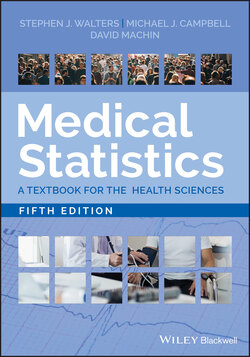Читать книгу Medical Statistics - David Machin - Страница 86
Issues with NNT – Always Consider all the Risks
ОглавлениеConsider a test and a control treatment with success rates (proportion of patients on the treatment with a positive outcome) of PTest and PControl respectively. Table 3.5 shows several scenarios that have the same RD, PTest−PControl, of 0.1 and NNT of 10 but different risks (of a positive outcome) and relative risks (RRTest/Control) and odds ratios (ORTest/Control). When interpreting a NNT it is important to consider the baseline risk or event rate in the control group. For example, in scenario 1, the new test treatment still only has a success rate of 10% (compared to an admittedly poor success rate of 0.1% in the control group). That is, only one out of 10 treated patients are likely to benefit on the new treatment but this gives the same NNT as scenario 7 where the success rate on the control treatment is a much higher 80% (that is, 8 out of 10 treated patients are likely to benefit on the control treatment compared to 9 out of 10 on the new treatment).
Table 3.5 Seven scenarios with the same NNT but different risks.
| Scenario | P Test | P Control | P Test − PControl | NNT | RRTest/Control | ORTest/Control |
|---|---|---|---|---|---|---|
| 1 | 0.1001 | 0.0001 | 0.1 | 10 | 1001 | 1112 |
| 2 | 0.101 | 0.001 | 0.1 | 10 | 101 | 112 |
| 3 | 0.11 | 0.01 | 0.1 | 10 | 11 | 12 |
| 4 | 0.15 | 0.05 | 0.1 | 10 | 3 | 3 |
| 5 | 0.2 | 0.1 | 0.1 | 10 | 2 | 2 |
| 6 | 0.6 | 0.5 | 0.1 | 10 | 1.2 | 2 |
| 7 | 0.9 | 0.8 | 0.1 | 10 | 1.1 | 2 |
Without stating the direction of the effect, the alternative treatment, the treatment period, and the follow‐up period, information in terms of NNTs is uninterpretable. Thus when quoting an NNT one should always give the basic information about which treatments are compared, the treatment period, the follow‐up period, and the direction of the effect.
